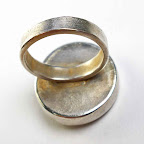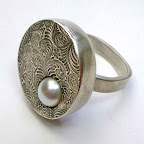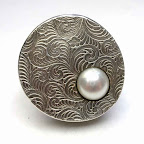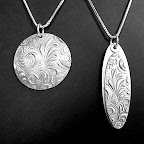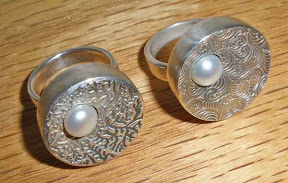I just realized it’s been almost two weeks since I posted anything. Sigh… I realized that around the same time it hit me that it’s been just under a month since I last fired up my kiln. Yikes! Where has the time gone?!
It’s not that I’ve been completely slacking off, mind you. It’s more that I do not see this whole art-jewelry adventure as a “full time job” (and do not ever want to see it that way … by which I mean that, no matter how many or how few hours I work at it, I don’t want to ever let it even approach a feeling of drudgery!). So sometimes I decide to take things a little bit easier, to take time to just enjoy what I’m doing. In addition to the things I have posted about in recent weeks, I’ve attended market-shows, visited museums and galleries, and so on.
Mid-month, I held an Open House in my studio, where I did make a number of pieces just to demonstrate the process for visitors. Because those were done to illustrate one or more points about working with metal clay (rather than from some specific design I had in mind), I then just smushed most of them back up afterwards so I could use the clay in a more deliberate manner later on. I did finish and keep a few but, feeling no pressure to complete them immediately, I just set them on my to-be-fired tray for when I had more of a kiln load. I guess I could have taken photos and written about any or all of those activities, but I decided to simply enjoy doing all those things, without thinking about using them here. Same thing with most of the other activities I’ve been involved with recently, like events with the Master Gardeners (as well as with my own garden), spending time with friends visiting from out of town, etc.
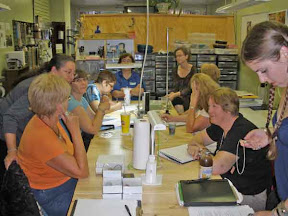 We did have a meeting of the Western PA Chapter of the PMC Guild. That was on Tuesday, out at the Four Directions Jewelry Studio that chapter-member Barbara Kaczor recently opened out in Springdale, PA. The photo shows some of the folks in attendance that evening. (That’s Barbara on the left, standing up and leaning over between Alice and Michelle.) The group had not had a formal meeting in a while, so it was great to get together with everyone again, see what all they’ve been up to, and share inspiration and discoveries. As always, we started out with a Show & Tell session (which included metal clay pieces and traditional metalsmithing, but also reports of surgeries, weddings, and travels… we’re pretty flexible about what gets included!). We dealt with some “business issues” and had some refreshments (for which, thanks to new-participant Susie, I was not the only one who brought a dish containing edible flowers!). We finished up with a lively discussion of making your own textures using the “tear-away technique.”
We did have a meeting of the Western PA Chapter of the PMC Guild. That was on Tuesday, out at the Four Directions Jewelry Studio that chapter-member Barbara Kaczor recently opened out in Springdale, PA. The photo shows some of the folks in attendance that evening. (That’s Barbara on the left, standing up and leaning over between Alice and Michelle.) The group had not had a formal meeting in a while, so it was great to get together with everyone again, see what all they’ve been up to, and share inspiration and discoveries. As always, we started out with a Show & Tell session (which included metal clay pieces and traditional metalsmithing, but also reports of surgeries, weddings, and travels… we’re pretty flexible about what gets included!). We dealt with some “business issues” and had some refreshments (for which, thanks to new-participant Susie, I was not the only one who brought a dish containing edible flowers!). We finished up with a lively discussion of making your own textures using the “tear-away technique.”
Since that ran late, and Alice lives a lengthy drive away, she stayed over at my place. We went back to my studio the next morning, right after breakfast. Alice sat down at one table and began designing a bracelet she wants to make, and I spent a bit of time getting studio back in order for working. (It had been in Open House configuration.) I just sat down to start working when Alice got a text from her husband, asking if she’d be back in time to go out for dinner with “the Holders.” Problem is, she couldn’t think of anyone named Holder! After several more text messages, the situation was clearer: the “Holders” is what his phone thought he meant when he tried to type in “the golfers” — meaning the people that he was out with for the day! Once she finished her design, in its preliminary state at least, she decided that it was too complex to finish in one afternoon, so she’d be better off heading home. She said her farewells, and I got back to serious work.
I spent the afternoon and evening making several “trial” pieces out of Hadar Jacobson’s relatively new “Rose Bronze” clay! Though I’ve enjoyed working with many of her other products, that was my first-ever use of the rose bronze. Those pieces are in the kiln now: noting their firing in my log book is what showed me how long it had been since the last time I’d fired it up.
I don’t like to sit right in the room as binders are burning away, but neither do I feel comfortable just leaving the building as the kiln fires. So I took my laptop over to another room in the building that houses my studio, and started this post.
These pieces are only going to get their first-phase firing tonight; when they’re done, I’ll take them out of the kiln. They can cool down on their own, but too much carbon will burn up if I just leave them in the kiln. (That extra fiddling, and multi-phase firings, are among the reasons that creating with the base metal clays seems more labor-intensive than do the precious metals!) It may be a couple days before I find time to fire the second phase. I’ll post results, good or bad, once I see what I’ve gotten and done some post-fire finishing on them. Please wish us good luck!
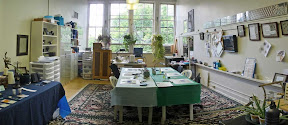
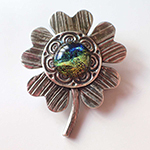 Artsmiths of Pittsburgh
Artsmiths of Pittsburgh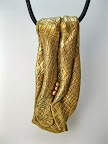 Hoyt Center for the Arts, New Castle, PA
Hoyt Center for the Arts, New Castle, PA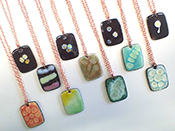 Portage Hill Gallery, Westfield, NY
Portage Hill Gallery, Westfield, NY _Open Houses in my Studio
_Open Houses in my Studio _Or…contact me about hosting a private party!
_Or…contact me about hosting a private party!

